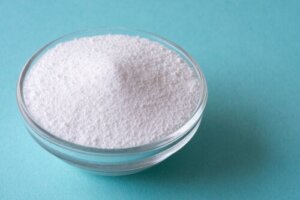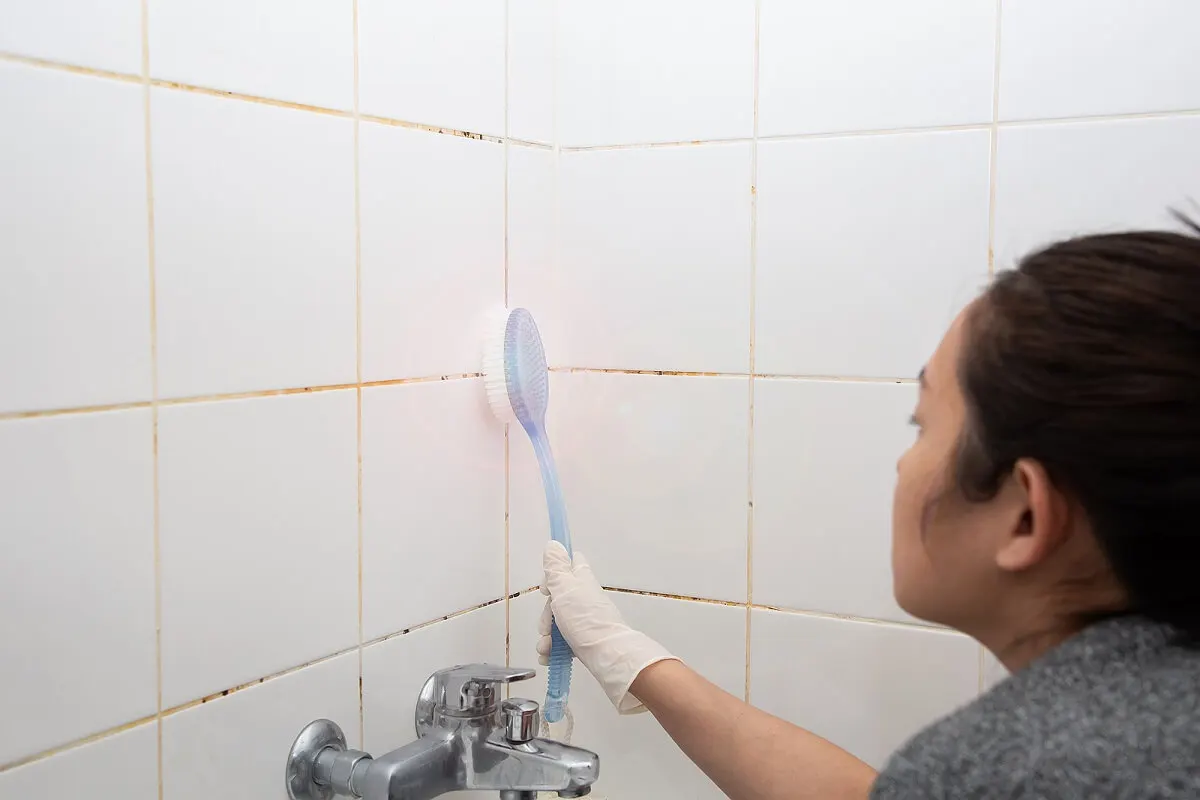The Effects of Borax Poisoning and How to Use It With Care

Borax poisoning can occur in several ways: through inhalation, ingestion, or skin contact. In turn, it can cause different effects, such as respiratory problems, digestive problems, and irritation.
This substance is present in cleaning products, laundry detergents, and even cosmetics. It’s also an ingredient in the slime that children play with. Young children are considered to be most at risk of reactions, even at lower doses.
Therefore, it can’t be considered a completely safe substance. And while it isn’t necessary to go as far as to rule it out completely, borax should be used with care, taking some precautions.
What is borax and what is it used for?
Borax, also called sodium tetraborate or sodium borate, is a water-soluble salt. This alkaline chemical can be found on the market in the form of a white powder.
It’s also an ingredient in a wide variety of products with different purposes, including cleaning, laundry, personal care cosmetics, among others. Sodium borate is found in toothpaste, mouthwashes, lotions, skin creams, moisturizers, sunscreens, paints and enamels, and herbicides, as well as the slime for children we mentioned earlier.
In this sense, its uses and applications, both domestic and industrial, are diverse:
- To eliminate mildew and mildew stains
- Disinfectant, bleach, and stain remover for clothes
- Odor neutralizer
- Pest and insect control
- Antifungal for feet
- Wood preservation
- In fire extinguishers
- In the food industry to thicken or give texture
- Hard water softener
- Melting element in welding
- A compound in glass and ceramics
- Colorant in fireworks

Read more here: How to Make Eco-Friendly Detergent from Borax and Baking Soda
Symptoms of borax poisoning
In small concentrations, borax isn’t necessarily toxic. If it were, it wouldn’t be included in cosmetic products or foods. But when it’s in its pure form and in larger quantities, it can cause different reactions.
These vary, depending on whether the substance is inhaled, ingested, gets on the skin, or comes into contact with mucous membranes. In turn, the intensity of the reaction increases when the contact is maintained over time.
Skin contact
Experts believe this substance can be absorbed through the skin. Possible effects of borax poisoning by dermal contact include dryness, irritation, redness, itching or stinging, as well as pain.
If contact is prolonged, eczema, erythematous rashes, and psoriatic dermatitis may be triggered. According to research, cases of contact dermatitis have been observed in children as an allergic reaction to handling household putty (slime) made with glue, borax, and dyes.
Mucosal reaction
Contact with mucous membranes, particularly the eye, may cause irritation, inflammation, and pain. Continuous or repeated exposure may lead to allergic conjunctivitis.
Borax inhalation
The maximum exposure limit is estimated to be a concentration of 2 milligrams (mg) of borax per cubic meter (m3) of air, over eight hours. Or 6 mg/m3 if the time period is short (less than 15 minutes).
Above these levels, borax poisoning may occur.
In case of inhalation, different effects may occur:
- Dryness of mucous membranes
- Irritation of the respiratory tract
- Reddening of mouth, nose and throat
- Cracking of the lips
- Respiratory impairment
- Pulmonary edema
In people who work handling this substance, other symptoms are also mentioned, such as a dry cough, nosebleeds, sore throat, bronchitis, and laryngitis. However, some studies report that, after examining for several years the respiratory symptoms of workers exposed to sodium borate, no evidence was found of a change in lung function that could be related to cumulative exposure.
Ingestion of borax
Ingesting sodium borate in high doses can cause gastrointestinal problems, such as nausea, vomiting, diarrhea, and abdominal pain, as well as headaches, muscle spasms, and general weakness.
It may even affect kidney and central nervous system function. In severe cases, shock, drop in blood pressure, tachycardia, oliguria, and cyanosis occur.
It is estimated that 10 to 25 grams could be lethal for adults (0.4 to 1 oz) and between 5 to 6 grams for children (0.2 oz).
Other effects
According to a review conducted in 2021, borax poisoning is considered to have effects on animal gestations, showing a reduction in fetal weight of 20%. However, there’s no evidence of the same in humans. Nor has it been associated with carcinogenicity.
Read more here: How to Store Cleaning Products Safely
Precautions when using borax
The first recommendation is not to purchase or make putty for children that contains sodium borate. Not only can they suffer skin irritations, but they’re also likely to put their hands in their mouths.
On the other hand, although borax is an effective alternative for cleaning and fighting pests, it’s advisable to take precautions during handling, given its potential toxicity.
Among the safety recommendations in this regard, the following should be taken into account:
- Avoid contact with the skin
- Don’t ingest in any way
- Use natural alternatives for cleaning
- Use gloves, a face shield, or a mask and goggles
- Don’t use this substance without prior information regarding its handling
- Keep at room temperature, in tightly closed containers and out of the reach of children and pets
- Set aside and then wash clothes and footwear used while handling the substance

What to do in cases of borax poisoning
In cases of borax poisoning, the measures to be taken will depend on the form of contact. Here are some guidelines:
- Eye contact: Wash immediately with plenty of water. Open and close the eyelids several times. Remove contact lenses.
- Skin contact: Remove clothing, wash skin with soap and water, and wash clothing thoroughly before reuse.
- Inhalation: Move the person who inhaled the borax into the fresh air. In case of difficulty in breathing, oxygen should be given (the emergency services should be called).
- Ingestion: If the person is conscious, make them drink several glasses of water or milk. Afterwards, supportive hydration may be required, as well as antiemetics and electrolytes. Sometimes vomiting will have to be induced, and you’ll also need to call the emergency services. Activated charcoal isn’t recommended.
Is borax safe?
Both the U.S. Food and Drug Administration (FDA) and the European Chemicals Agency (ECA) consider borax as a restricted substance because of its potential impact on soils.
However, the American agency doesn’t disapprove of its use in food additives. There are also restrictions regarding its presence in body care products formulated for children under 3 years of age.
However, it can be used for cleaning or as a laundry detergent, among other purposes, provided that precautionary measures are taken and contact with skin or eyes and inhalation or ingestion are avoided.
All cited sources were thoroughly reviewed by our team to ensure their quality, reliability, currency, and validity. The bibliography of this article was considered reliable and of academic or scientific accuracy.
- Hadrup N, Frederiksen M, Sharma A. Toxicity of boric acid, borax and other boron containing compounds: A review. Regulatory Toxicology and Pharmacology. 2021. https://doi.org/10.1016/j.yrtph.2021.104873.
- Ibáñez, C, Mantero, C, Silva, L, Rabinovich, M, Escudero, R, & Franco, J. (2012). Preservación de madera tratada con Zn y Mn y efectividad de tratamiento antilixiviante con bórax. Maderas. Ciencia y tecnología, 14(2), 165-174.
- Kotevska B, Demerdjieva Z, Tsankov N, Kazandjieva J. Allergic Contact Dermatitis Caused by Homemade Slime. Serbian Journal of Dermatology and Venereology. 2018; 10 (2): 52-56
- Young J. Borax. J. Chem. Educ. 2001; 78(5): 588. https://doi.org/10.1021/ed078p588.
- Wegman D, Eisen E, Hu X, et al. Acute and chronic respiratory effects of sodium borate particulate exposures. Environmental Health Perspectives. 1994; 102(suppl): 119-128.
This text is provided for informational purposes only and does not replace consultation with a professional. If in doubt, consult your specialist.








